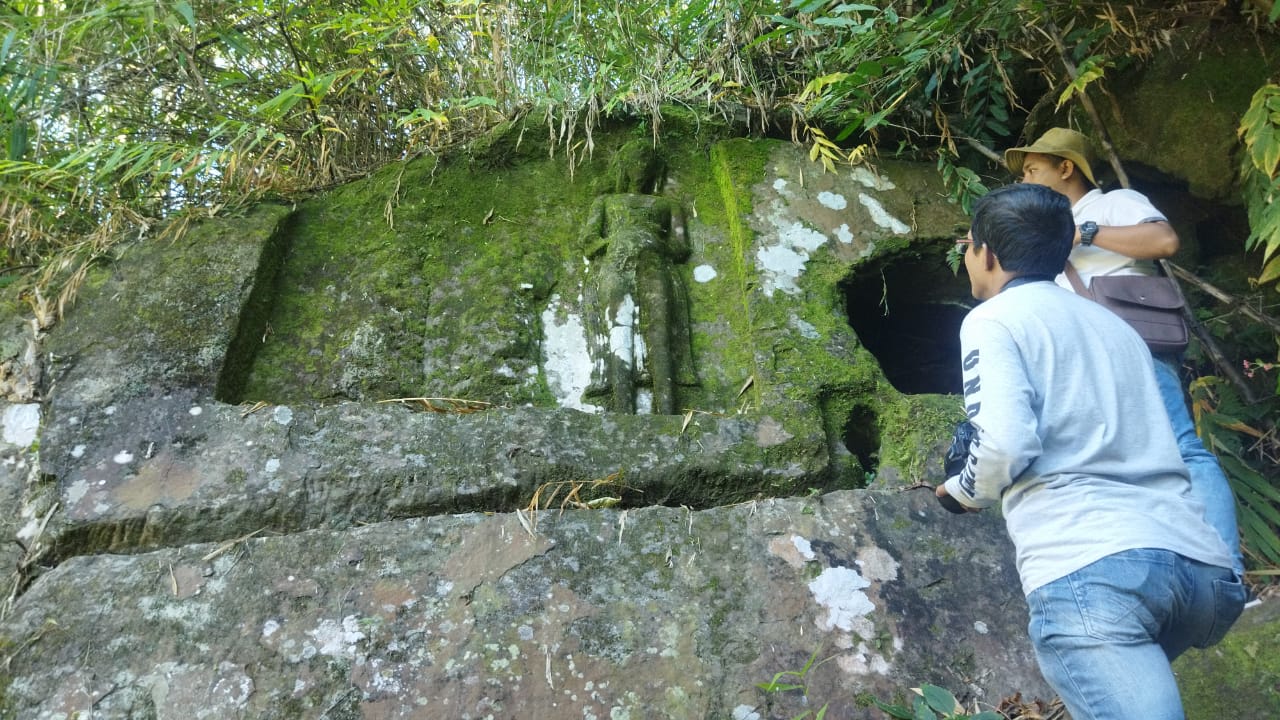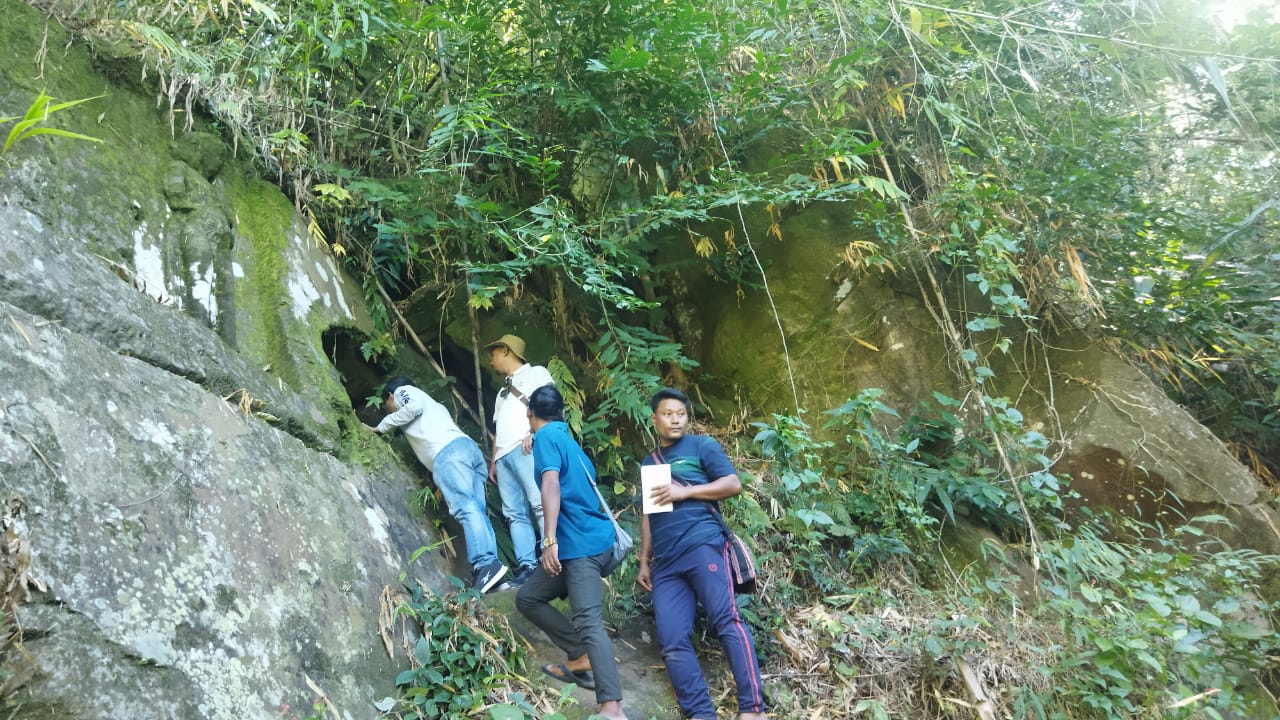SILCHAR: In a significant discovery, a professor and research scholar from Assam University in Silchar reported finding 1,500-year-old (8th century) sculptures influenced by Hindu and Buddhist traditions near the Assam-Mizoram border. Ganesh Nandi, Assistant Professor at Assam University’s Department of Visual Arts, and researcher Binoy Paul made the discovery in the Kolalian village, Mizoram, adjacent to Hailakandi district in Assam.
The duo divulged that they had to travel through the forests for almost a whole night from Assam’s Hailakandi district, crossing the Assam-Mizoram state border, to reach their destination. The sculptures, found after a night-long journey, resemble those in Tripura’s Unakoti and Pilak, believed to be from the 7th to 9th century. While one idol resembles Lord Buddha in attire and style but appears female, Nandi suggested it may have similarities with Buddha idols in Cambodia.
“We believe that the sculptures found in Kolalian were created in a similar period. We cannot be sure if it is a Buddha or a Hindu deity but the art form has similarities with the Buddha idols found in Cambodia,” Nandi told The New Indian.
The researchers connected the discovery to historical events mentioned in The Rajmala, stating that Maharaja Dhanya Manikya sent General Rai Kachak to control Reang rebels, who performed Durga Puja in the region. The art style aligns with the Gupta and Paul periods (750-1200 CE). The researchers highlighted the need for detailed research to confirm the sculptures’ origin.
“There were many small kingdoms under Tripura’s Manikya Kingdom and this small Reang group was one of them. As per the local folktales, Rai Kachak stayed here for a few times and he performed Durga Puja at this hill,” he said.
As per The Rajamala, Dhanya Manikya was the Maharaja of Tripura between 1490 and 1515 CE and Rai Kachak was his general. Many temples with beautiful stone works including Tripura Sundari Temple in Udaypur were constructed during Dhanya Manikyas reign.
However, there is no evidence if the stone works in Kolalian were created during that period. Nandi said that the art form of these sculptures is similar to the art forms found during Gupta and Paul periods (between 7500-1200 CE).
“Considering the style of stone works, the ornaments, dress of the idols, we can say this is very much similar to the stone of works done during Gupta and Paul periods. These references are found in Tripura’s Unakoti and Pilak as well. I wish we could see more idols here,” he said.
Nandi captured images of the damaged idols and, upon further investigation, observed that the ornaments, particularly on the female structures, bore similarities to stone works from the Paul and Gupta periods.
Nandi and Paul asserted that the site had remained undiscovered by the Archaeological Survey of India (ASI) and past researchers, with locals safeguarding the stone works as sacred deities.
“When we reached the spot, the local residents from Reang community said that nobody ever went there for research. According to our research, these sculptures are undoubtedly the oldest of such art works in Barak Valley’s history,” he said.
The locals in Kolalian recalled that the entire hill was once adorned with various artworks, but only a few remain. They expressed their belief in the Hindu religion, stating that for generations, they have been offering prayers to these idols as Hindu gods and goddesses.
Another local, Pradip Kumar Reang, mentioned the existence of forts and various stone works related to Reang Tribal kings in Kolalian, Rengdil, and surrounding areas. Unfortunately, many of these were destroyed by outsiders.
He explained that prior to 1989, this region was part of Assam, and attacks began after it became part of Mizoram. Outsiders reportedly used grenades and other weapons to destroy these stone works, estimating that 90 per cent of these precious sculptures have been lost.
Despite facing vulnerability and limited protection, the residents consistently called on researchers, people from mainland India, and journalists to showcase and protect these works.
“We worship them as Durga, Shiva, Lakshmi, Vishnu and Ganesh. Our entire civilisation is surrounded by this belief. Even the priest is doing their duties for many generations. We are vulnerable, weak, and less protected but our beliefs are unbreakable,” he added.
Senior researcher and former vice-chancellor of Assam University Silchar, Jayanta Bhushan Bhattacharjee, expressed surprise at the existence of such crucial works in this region. He noted that the best historical book about this area, authored by Upendracandra Guha, did not reference Kolalian.
Discussing the geographical history, Bhattacharjee suggested that in the early centuries, the civilisation on this plain land was vast, forming a triangle at Tripura, Srihatta (Sylhet), and the connecting area of the Dimasa Kingdom. Kolalian, located near this triangle, was once part of Surma Valley.
“If we look at the geography, Unakoti, Pilak, and this Kolalian are on a typical geographical route and it is very much possible that the sculptures found in Kolalian, are more than 1,000 years old,” he said.
While acknowledging the oral nature of the region’s history and the lack of evidence, Bhattacharjee emphasised that the discovery by Nandi and his scholar has the potential to reshape the history of Barak Valley and surrounding areas.
Calling for the preservation and protection of these findings, he remarked, “We lost many historical monuments but now this has to be preserved and protected. The Archaeological Survey of India is coming to visit the place and they may find more works there,” he said.










